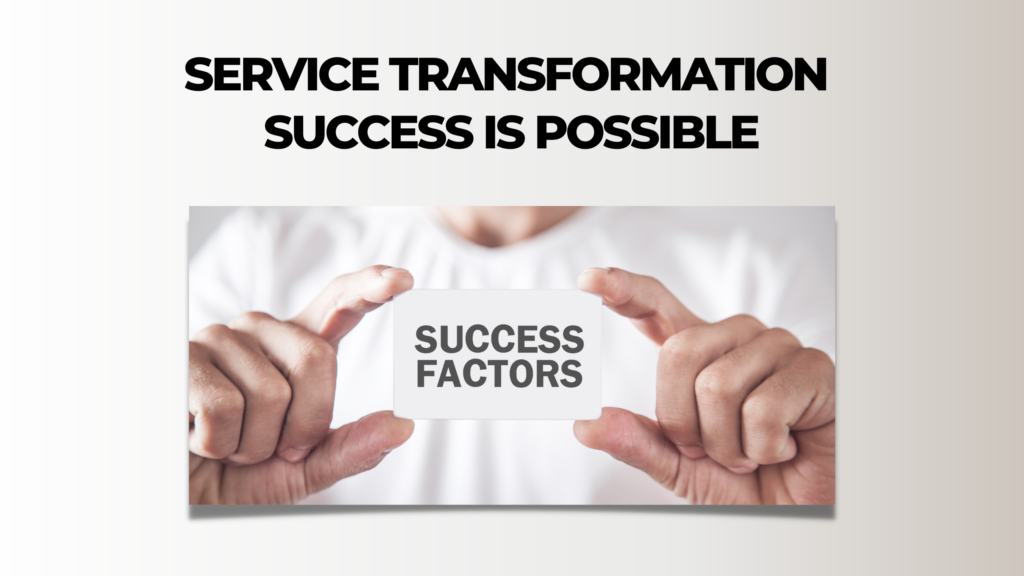Sometimes service improvement efforts fail. There, I said it. So why would a service transformation consultant make such a counter-productive statement? Because that’s the reality at times. Whilst not all improvement efforts hit the mark, many of the pitfalls that are encountered are avoidable.
There are two levels of service elevation. Level one is about “improvement” of the customer’s experience, whilst level two is about the “sustainability” of a superlative level of service excellence. In my experience as a consultant, many businesses are happy to stop at an improved level and are unwilling to commit the time, energy, effort and resources to get to and to stay at, a sustainable level that boasts superlative service outcomes.
If a business starts its transformation journey by locking in these critical success co-ordinates, the change effort stands a better chance of landing successfully.
There are two sad realities about the improvement level. One is that businesses think that it will last (and it doesn’t). The other reality is that some businesses prefer this quick and dirty approach, because the output of resources is not too onerous and, with the right rollout actions, incremental shifts in customer experience are achieved. Both the business and its customers notice the visible improvements and everyone is buoyed by the results. But the crash can occur if this situation turns into a merely cosmetic fix. Without the right anchors in place to convert short-term change into a permanent solution, the old status quo becomes normalized all over again, taking the business back to square one.
What dawns on the business, is that sustaining the improvement to the point where changes are imbedded, is a different pot of stew altogether. Some businesses do their best to rally for as long as they can with the minimum improvement levels, only to run out of steam eventually.
Getting to improvement level is fairly straightforward, especially when the model being used is robust and purpose designed. This model would include re-envisioning the new service destination, activation of change drivers, training and introduction of behaviour reinforcement levers. But, the model has to be sustained, to achieve any real, or lasting impact.
Valuing consistency in achieving change results, over enforcing rigid timelines for achieving change, is one important factor that will help a business to focus on the right levers.
When a business decides to go the service transformation route, that’s a whole different ball game. There’s an understanding of the need to for patience, discipline, trusting the change process and commitment to navigating the difficult flight path on the way to the end game of service excellence.
If a business starts its transformation journey by locking in these critical success co-ordinates, the change effort stands a better chance of landing successfully.
Let’s take a look at some factors that can improve the service transformation hit rate.
Valuing consistency in achieving change results, over enforcing rigid timelines for achieving change, is one important factor that will help a business to focus on the right levers. Sometimes change cannot be forced. Far too often business leaders ascribe a specific timeline for which the transformation journey should start and end, without factoring in the time that remediation of intrinsic business problems will add to the service-specific rollout. Measuring progress is far more productive than measuring timelines.
An obsessive focus on gaining traction by connecting the business with its customers’ passion points is critically important.
An obsessive focus on gaining traction by connecting the business with its customers’ passion points is critically important. When there’s a seriously unwavering conviction to shift the needle from merely satisfying customers, to getting them to become adoring fans, service transformation qualifies to be treated like a navy seal mission.
Many businesses are focussed, but not “consumed passionately,” with getting results from their transformation projects. Big mistake. When transformation projects only enjoy a lukewarm embrace by business leaders, shifts are neither permanent, nor impactful. Passion, paired with a robust change model, yields sustainable results.
Can you imagine the ground-breaking customer engagement that will ensue, if a bank decided to ensure that all of its employees were “passionately consumed” with their customers’ passion points? Can you imagine interacting with tellers, counter representatives and contact centre agents who breathe and exude “customer care” as a way of life? Customers would swoon with delight and open their wallets without being prompted.
Passion, paired with a robust change model, yields sustainable results.
Change happens through evolution, revolution or devolution.
In a competitive market, where in almost every sector, products and services are undifferentiated, service delivery evolution would mean incremental change, at a slow to moderate speed. Revolution would mean consistently innovative customer outcomes and devolution would mean, well……….an epitaph in the business obituaries.
So, going forward, what will service transformation mean to your business? Evolution, revolution or devolution? There’s always a choice.

